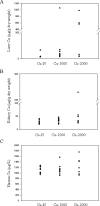Decreased erythrocyte CCS content is a biomarker of copper overload in rats
- PMID: 20717526
- PMCID: PMC2920556
- DOI: 10.3390/ijms11072624
Decreased erythrocyte CCS content is a biomarker of copper overload in rats
Abstract
Copper (Cu) is an essential trace metal that is toxic in excess. It is therefore important to be able to accurately assess Cu deficiency or overload. Cu chaperone for Cu/Zn superoxide dismutase (CCS) protein expression is elevated in tissues of Cu-deficient animals. Increased CCS content in erythrocytes is particularly sensitive to decreased Cu status. Given the lack of a non-invasive, sensitive and specific biomarker for the assessment of Cu excess, we investigated whether CCS expression in erythrocytes reflects Cu overload. Rats were fed diets containing normal or high levels of Cu for 13 weeks. Diets contained 6.3 +/- 0.6 (Cu-N), 985 +/- 14 (Cu-1000) or 1944 +/- 19 (Cu-2000) mg Cu/kg diet. Rats showed a variable response to the high Cu diets. Some rats showed severe Cu toxicity, while other rats showed no visible signs of toxicity and grew normally. Also, some rats had high levels of Cu in liver, whereas others had liver Cu concentrations within the normal range. Erythrocyte CCS protein expression was 30% lower in Cu-2000 rats compared to Cu-N rats (P < 0.05). Notably, only rats that accumulated high levels of Cu in liver had lower erythrocyte CCS (47% reduction, P < 0.05) compared to rats fed normal levels of Cu. Together, these data indicate that decreased erythrocyte CCS content is associated with Cu overload in rats and should be evaluated further as a potential biomarker for assessing Cu excess in humans.
Keywords: CCS; biomarker; copper overload; erythrocytes; rat.
Figures



Similar articles
-
Copper chaperone for Cu/Zn superoxide dismutase is a sensitive biomarker of mild copper deficiency induced by moderately high intakes of zinc.Nutr J. 2005 Nov 24;4:35. doi: 10.1186/1475-2891-4-35. Nutr J. 2005. PMID: 16307684 Free PMC article.
-
Copper deficiency induces the upregulation of the copper chaperone for Cu/Zn superoxide dismutase in weanling male rats.J Nutr. 2003 Jan;133(1):28-31. doi: 10.1093/jn/133.1.28. J Nutr. 2003. PMID: 12514262
-
Erythrocyte copper chaperone for superoxide dismutase and superoxide dismutase as biomarkers for hepatic copper concentrations in Labrador retrievers.Vet J. 2016 Dec;218:1-6. doi: 10.1016/j.tvjl.2016.10.007. Epub 2016 Oct 25. Vet J. 2016. PMID: 27938702
-
Cu,Zn-superoxide dismutase is lower and copper chaperone CCS is higher in erythrocytes of copper-deficient rats and mice.Exp Biol Med (Maywood). 2004 Sep;229(8):756-64. doi: 10.1177/153537020422900807. Exp Biol Med (Maywood). 2004. PMID: 15337829
-
Metallochaperone for Cu,Zn-superoxide dismutase (CCS) protein but not mRNA is higher in organs from copper-deficient mice and rats.Arch Biochem Biophys. 2003 Sep 15;417(2):227-34. doi: 10.1016/s0003-9861(03)00364-3. Arch Biochem Biophys. 2003. PMID: 12941305
Cited by
-
Development of an Immunoassay for the Detection of Copper Residues in Pork Tissues.Biosensors (Basel). 2021 Jul 13;11(7):235. doi: 10.3390/bios11070235. Biosensors (Basel). 2021. PMID: 34356706 Free PMC article.
-
Effects of Fructose and Stress on Rat Renal Copper Metabolism and Antioxidant Enzymes Function.Int J Mol Sci. 2022 Aug 12;23(16):9023. doi: 10.3390/ijms23169023. Int J Mol Sci. 2022. PMID: 36012287 Free PMC article.
-
Exploring the Extended Biological Functions of the Human Copper Chaperone of Superoxide Dismutase 1.Protein J. 2019 Aug;38(4):463-471. doi: 10.1007/s10930-019-09824-9. Protein J. 2019. PMID: 31140034 Review.
References
-
- Linder MC, Hazegh-Azam M. Copper biochemistry and molecular biology. Am. J. Clin. Nutr. 1996;63:797S–811S. - PubMed
-
- Bertinato J, L'Abbe MR. Maintaining copper homeostasis: Regulation of copper-trafficking proteins in response to copper deficiency or overload. J. Nutr. Biochem. 2004;15:316–322. - PubMed
-
- Field LS, Luk E, Culotta VC. Copper chaperones: Personal escorts for metal ions. J. Bioenerg. Biomembr. 2002;34:373–379. - PubMed
-
- Kaler SG. Metabolic and molecular bases of Menkes disease and occipital horn syndrome. Pediatr. Dev. Pathol. 1998;1:85–98. - PubMed
Publication types
MeSH terms
Substances
LinkOut - more resources
Full Text Sources
Medical

